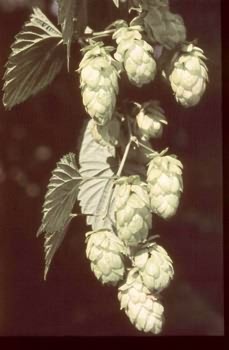Crops
Humulus lupulus L. - Hop, twisted
Regular position.
Family Cannabaceae Endl., genus Humulus L.Morphology and biology.
Perennial vine reaching 3-12 m in length. Stalks are strong, flexible, 8-15 mm thick, creeping, twisted, hexahedral. The rigid, uniform thorns are located along the sides and allow the plant to climb supports. Shoots are monocarpic, dying off in the winter. Rhizomes are modified underground stems. Leaves are opposite, 3-5-bladed (5-10-15 cm long), at the base heart-shaped, with saw-toothed edges and a long leafstalk. Entire leaf surface is covered by rigid hairs. Lateral shoots are formed from axils of stem leaves. Fine palmatipartited or heart-shaped integral petiolar leaves and generative bodies are developed on lateral shoots. Dioecious plant. Pistillate small-sized flowers (2 at the base of covering leaf), are collected in bunches of 20-60 in drooping strobiloformed catkin. The flower consists of an isolated, green, bowl-shaped perianth and a pestle. Sheathing leaves are covered by glands that secrete lupuline. Staminate flowers are flavovirent, with 5-leaved perianth and 5 stamens that are grouped in a paniculate inflorescence. Blossoms in July, seeds ripen in September. Hop cones vary in size from small (up to 2 cm), average (2-3.5 cm), large (3.6-5 cm) and very large (more than 5 cm). The fruit is a one-seeded nutlet, 2-4 mm long, oblate, lentil-shaped, brown, dark-lilac, brown-black color with various shades. The weight of 1000 seeds is 2-4 g.Distribution.
The origin of hop is presumptively the valleys and foothills of the Caucasus and the coast of the Black Sea. One of the oldest hop-growing areas of Russia is Guslitskij (the Moscow region). Hops are cultivated in the Ukraine, in Non-chernozem, Central, Central Chernozem areas, in the Volga region, and on Altai. The general area covers about 15 thousand hectares; productivity is 1.0-1.6 tons per hectare (as much as 2.2).Ecology.
It is photophilous. It is sensitive to heat, especially during flowering and the formation of cones. The optimum temperature for this species is 15-17°C without sharp fluctuations. It requires highly fertile, light soil with pH 6.0-7.5. This is a plant of moderately damp climates. Plants are cultivated by cuttings or seeds. Fructifies in the first year, but a good harvest is produced only in the second year. Productive period is 20 years or more. Staminate plants are destroyed, as the value of cones with seeds is lower because of the presence alkaloids. The following are varieties of this species: Ranny, Smolisty, Istrinsky 15, Kalistovsky, Bryansk, Serebrjanka, Clone 18, Urozhajny, and Polessky.Economic value.
Structure of the cone hop is as follows: water 8-13%, cellulose 12-16%, starch 2-5%, sugar 2-4%, nitrogenous substances 13-18%, amino acids 0.1-0.2%, pectinaceous substances 5-15%, ashes 6-10%, general bitter substances 10-22%, essential oils 0.2-2.7%, tannins 2-5%. It is used in brewing, canning, baking, the cosmetic industry, medicine, pharmaceuticals and perfumery. Young shoots are used as an asparagus. A fiber suitable for the preparation of paper, yarn, and rope can be extracted from the stalks. A golden-yellow paint can also be developed from the hop. The vegetative weight serves as forage for cattle. It is a decorative plant.Reference citations:
Alexandrov N.A. 1991. Hop. Moscow: Rosagropromizdat. 128 p.Ezhov I.S., ed. 1990. Hop and its using. Kiev: Urozhaj. 336 p.
Libatskij E.P. 1993. Hop growing. Moscow: Kolos. 288 p.
Tolmachev, A.I., ed. 1976. Flora of northeast of the European part of the USSR. V. 2. Leningrad: Nauka. 316 p.
Vehov V.N., Gubanov I.A., Lebedeva G.F. 1978. Cultural plants of the USSR. Moscow: Mysl'. 336 p.
Vinogradov V.N. 1977. Hop growing. Gor'kiy: Gor.kiy Agricultural Institute. 80 p.


